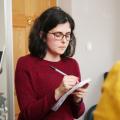
A neuroscientist from Melbourn has become the first profoundly deaf person to use LED lights to communicate during cancer treatment.
Caroline van der Westhuizen, 49, who uses the surname 'Benn' professionally, lost her hearing after contracting meningitis as a child.
She later went on to obtain her PhD from King's College London and realised her ambition of becoming a neuroscientist.

In March 2021, at the age of 47, Caroline was diagnosed with Stage 3 ER positive breast cancer, and successfully underwent chemotherapy and surgery to remove the tumour, followed by radiotherapy.
However, in September 2022 Caroline received the news she had a second tumour in her left breast, and underwent further surgery and chemotherapy.
After this second mastectomy, Caroline was advised she'd need a more complex therapeutic approach.
She was recommended to GenesisCare in Cambridge for specialist radiotherapy treatment - involving a breathing technique called deep inspiration breath hold (DIBH).
Caroline said: "The deep inspiration breath hold technique usually involves the radiographer telling you over an intercom when to take a deep breath and hold it, to separate your chest wall away from your heart.
"When I went to GenesisCare and we discussed my previous communication challenges, the team were excellent and came up with a relatively easy solution that would work for me."
To help Caroline communicate with her radiotherapy team, she used an LED 'traffic light' system - which is now being rolled out to other GenesisCare centres in the UK to help other hearing-impaired patients.
Caroline added: "It was a pivotal moment for me, I felt truly heard."
Yasmine Tate, lead therapy radiographer at GenesisCare Cambridge, said: "We discussed how best to facilitate visual prompts to communicate to Caroline during treatment via simple 'breath in' and 'breath out' instructions that she could understand.
"We brainstormed a few ideas and decided that if we used a simple set of LED lights and attached them to the real time coach, a device that gives the patient an indication where to breathe up to then we could switch the lights to green when we were ready for Caroline to take a breath in, then back to red again when she could breathe normally. It worked!"
The treatment has since been presented at the European SGRT (Surface Guided Radiation Therapy) conference in London.
Caroline, who has two daughters age 12 and 7, wants to encourage others to speak up if they struggle during treatment.
She said: "I‘m so thankful to the GenesisCare team for listening to me and devising a truly personalised solution - and I’m thrilled this method is now being used to help other hearing-impaired breast cancer patients.
"With the LED lights and the simple stop-go system, I knew exactly what I needed to do, when.

"I always felt reassured and supported by the team and more importantly I always felt safe.
"I'm thrilled that the LED technique will be used to help other patients.
READ MORE
- Royston families to have increased access to early years childcare
- Addenbrooke's to open £3m health research centre for brain and spinal injuries
"I’m very proud to be involved in this medical ‘first’ and play a small part in helping other patients with hearing difficulties – which could include older people or people whose first language isn’t English - receive the cancer treatment and care they deserve."
Caroline completed her cancer treatment in August 2023, and now feels well enough to indulge in her passion for high-adrenaline sports.
She said: "No red lights for me. Life is all about the green lights now – go, go, go."



Comments: Our rules
We want our comments to be a lively and valuable part of our community - a place where readers can debate and engage with the most important local issues. The ability to comment on our stories is a privilege, not a right, however, and that privilege may be withdrawn if it is abused or misused.
Please report any comments that break our rules.
Read the rules here